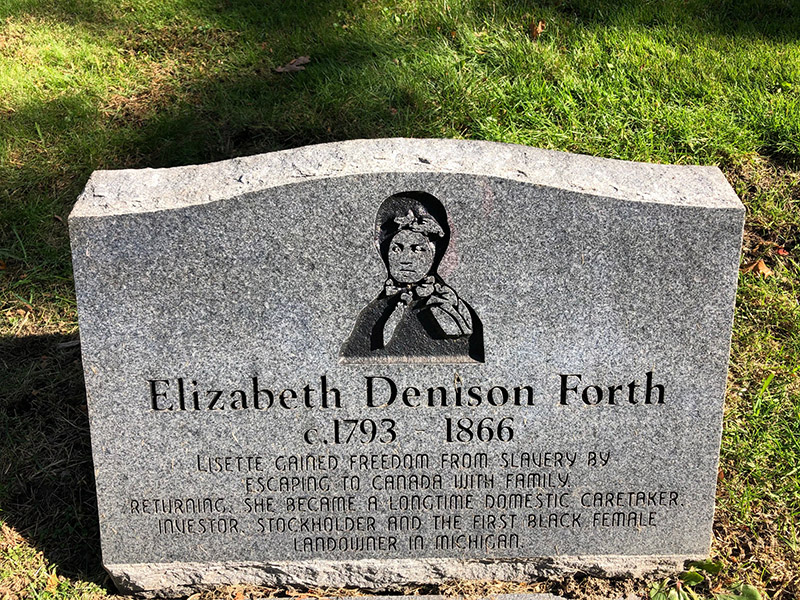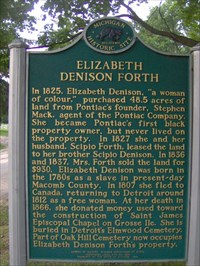 Click here to view or download a PDF.
Click here to view or download a PDF.
Elizabeth Denison Forth, also known as Lisette, was born into slavery in the 1780s. She was the daughter of slave parents Peter and Hannah Denison. She was born on the William Tucker farm along the Huron River of St. Clair, now called the Clinton River. When Tucker died in 1805, he specified that Peter and Hannah Denison would be freed after his wife Catherine Tucker’s death, but willed the Denison children to his brother.
Peter and Hannah went to work for Elijah Brush who encouraged them to sue for the freedom of their children under the Northwest Ordinance, which prohibited slavery in the territory. In the legal battle, Denison vs. Tucker, Lisette and her brother failed to obtain freedom through the Supreme Court of Michigan Territory because they were born prior to the effective date of the Northwest Ordinance. Soon afterward, Judge Augustus B. Woodward ruled that the Michigan Territory had no obligation to return slaves to slavery who had been freed by establishing residence in Canada. Following this legal precedent, in 1807 Lisette and her brother crossed into Canada with their parents and siblings, established residency, and gained their freedom. Scholars surmise that Elijah Brush aided their escape and residency in Canada.
Lisette returned to Michigan in 1812 and was employed by several prominent families in Detroit doing housework. She had a close relationship with her employers and invested her pay in land. In 1825, she purchased 48.5 acres of land in Pontiac, Michigan, becoming the first black property owner in the city. A Michigan Historical Marker commemorates her ownership.
In 1827, she was married to Scipio Forth, the owner of a freight business. The marriage is entered on the records of St. Paul’s Protestant Episcopal Church in Detroit. Apparently, Lisette became a widow within three years of the marriage.
In 1831, she was employed by Detroit Mayor John Biddle and spent the next 30 years working for the family. She continued to invest, buying stock in a steamboat and a bank as well as a lot in Detroit. John Biddle built an estate downriver that he named Wyandotte. Lisette was with the Biddles until 1849 when the Biddles returned to Philadelphia. Once they were settled, they asked Lisette to join them in Philadelphia. Later, while in France, Mrs. Biddle requested that Lisette join them in Paris. Lisette returned to Grosse Ile, Michigan in 1856 where she joined William Biddle, eldest son of John, and cared for his two oldest children for nearly three years.
Lisette and Mrs. John Biddle shared their Episcopal faith. Lisette was motivated by a donation to Mariner’s Church and wished to do the same in the downriver area. She made her wishes known to William Biddle. Since his mother also wished to have a chapel built, William consulted with brother James to determine how this could be done. James contributed some land. William had money from his mother and $3,000 from Lisette to build the chapel. It is believed he also contributed some of his own money. The chapel was named St. James Episcopal Church. It is positioned on East River Road, facing Canada, on Grosse Ile.
Neither of the two women was alive when the chapel was completed. Mrs. Biddle died in Philadelphia on November 3, 1865. She was buried in the Biddle Family Plot at Elmwood Cemetery on November 8, 1865. Nine months later on August 7, 1866, Lisette died and was buried in Stranger’s Ground T-45/G194.
Bishop Samuel Allen McCoskry consecrated St. James Episcopal Church in July 1868. In his later report to the diocese he stated:
This church is the fruit of a life of toil and service of a faithful colored servant of Christ. She had, for years, husbanded her earnings for this purpose, and, long before she was called away from her life of probation, had solemnly devoted them to the Church of Christ. This was done in connection with the design of one, whom she had, long and faithfully served, to unite with her in the holy act. Providential circumstances having prevented the accomplishment of the wish of this person, it was faithfully carried out by two of her sons, who liberally supplied the funds required to complete the church; and it now stands, in all its simplicity and beauty, as the joint act of a Christian household, to provide a house of prayer for the rich and poor.
The church’s red doors are dedicated to the memory and benevolence of Lisette Denison Forth and a Michigan Historical marker located on the site commemorate both the church and Lisette.

 The Michigan Historical Marker erected in honor of Elizabeth Denison Forth
The Michigan Historical Marker erected in honor of Elizabeth Denison Forth

This material is based upon work assisted by a grant from the Association for the Study of African American Life and History (ASALH), funded by the Department of the Interior, National Park Service. Any opinions, findings, and conclusions or recommendations expressed in the material are those of the author(s) and do not necessarily reflect the views of ASALH or the Department of the Interior. Elmwood Cemetery’s Network to Freedom Application was completed by Carol Mull and Gabrielle Lucci. This biography was completed based upon the Application and records available through Elmwood Cemetery, Detroit Historical Society, Burton Historical Library, Military Records of the United States, Michigan Historical Center, and various information sources.
